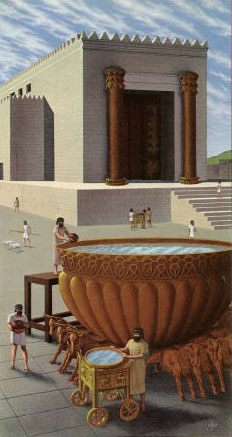Right Between the Eyes
Darren Doane’s finished the first half hour of Genesis Redux.

You know how it is when you read one of your favourite theologians and they come up with a real clanger? It’s yes, wow, yes, I’m with you, and then the train of thought jumps the tracks—at least as far as you, the reader, are concerned. It’s like me reading a good Presbyterian who without any warning flies off the wall and marries chalk and cheese to prove the Bible teaches infant baptism. Or it’s you reading this blog watching me fly off the wall every now and then (but it’s all completely logical in my mind—believe me! Bully is never wrong!)
Anyhow, J. L. Vaughan, a “Covenant Creationist” on the AV forum pointed out this article by Brian Godawa, who is both a theologian and a screenwriter. I have featured Brian’s articles on the Abrahamic Covenant, Matthew 24 and Daniel 9 on my old The Last Days page. He is logical and easy to understand. And he’s a preterist. But then he jumps the tracks (as far as I’m concerned) and goes and parrots this drivel:
Ben Witherington comments on the unearthing of a huge temple complex and its relevance to Genesis:
This temple lies west of the Biblical plain called Haran and is only 20 miles from the Syrian border. This places it right in the fertile crescent which begins below modern day Iraq, includings the Tigris and Euphrates rivers and winds its way north through Syria and into eastern Turkey. This is the world not only of Genesis, but of the great Anatolian civilization of the Hittites (yes those Hittites as in Uriah the Hittite—husband of Bathsheba)… Klaus Schmidt and his team of Kurdish diggers have uncovered an enormous temple complex that pre-dates the Great Pyramids by some 7,000 years and Stonehenge by at least 6,000 years!… After 12 years of hard work, Schmidt has found at least four temple complexes. The radar scans of the area indicate there is a huge amount more to uncover here. And Schmidt has a thesis about this temple complex—here is a short excerpt from the Newsweek article on this:
“Schmidt’s thesis is simple and bold: it was the urge to worship that brought mankind together in the very first urban conglomerations. The need to build and maintain this temple, he says, drove the builders to seek stable food sources, like grains and animals that could be domesticated, and then to settle down to guard their new way of life. The temple begat the city.”
The importance of this find for Biblical thinking is this—the Bible says that from the outset, human beings were created in God’s image. Human beings were religious creatures from Day One. Archaeologists and sociologists have long dismissed this theory saying organized religion comes much later in the game than the beginning of civilization and city building. As Ian Holder director of Stanford’s prestigous archaeology program says— this is a game changer. Indeed, it changes everything experts in the Neolithic era have been thinking. Schmidt is saying that religion is the cause of civilization, not the result of it. Towns were built to be near the Temple complex. Agriculture was undertaken to feed those living there and supply the temple complex, and so on. The first instincts of humans were to put religion first. Maybe there is more to that Genesis story than some have been willing to think or admit. Maybe human beings are inherently homo religiosis.
“And whanne Moises cam doun fro the hil of Synai, he helde twei tablis of witnessyng, and he wiste not that his face was horned of the felouschipe of Goddis word..” —Exodus 34:29, Wycliffe
Perhaps you’ve seen those bumper stickers that say, “If we’re not meant to eat animals, why are they made of meat?”
NOTE: THIS POST HAS BEEN REMIXED AND INCLUDED IN GOD’S KITCHEN.
You must be logged in to see the rest of this post.
Join now for a year for $15!
From memory, men didn’t eat meat until after the flood. The history from Adam to Noah follows the Feasts pattern, with Adam as the Alpha male (heh) and Noah as the mature and wise Omega male of that initial process. [1] Moving from vegetarianism (literally “seeds”) to meat was not only a sign of judgment, but a sign of greater judgment put into the hands of God’s Man. [2] Noah could eat meat, and he could also sentence murderers to death. Man now had teeth in a way he had never had them before. Even we use the phrase “toothless” to refer to ineffective pieces of legislation. As mentioned elsewhere here, teeth and tusks and ivory and horns are symbols of justice, whether they be on men, animals, or altars. [3] A blood-covered horn means the crime is atoned for. Just as Christ was a Lamb with seven horns, worthy to open the scroll, Moses came down from Sinai with not only a “scroll” (or tablets in that case) but “horns.” This translation has been dismissed as errant, but perhaps the reason for it should not be dismissed so easily. Here’s my attempt at an interpretation.
Now a river went out of Eden to water the garden, and from there it parted and became four riverheads. The name of the first is Pishon; it is the one which skirts the whole land of Havilah, where there is gold. And the gold of that land is good. Bdellium and the onyx stone are there. The name of the second river is Gihon; it is the one which goes around the whole land of Cush. The name of the third river is Hiddekel; it is the one which goes toward the east of Assyria. The fourth river is the Euphrates. (Genesis 2:10-14)
After the Herod and Shylock post, I had one complaint that the Worship as Commerce tag didn’t really do what it said on the tin, so I hope to capture it (briefly?) here. Now, where to start? As James Jordan explains, the idea begins in Eden.
Continue reading
These modern atheists are totally blind. Besides the fact that they give all the credit for the cultural achievements of Christianity to “human reason” (aren’t Muslims human, too?), they believe that social anarchy is freedom. After all, we are just pondscum, blindly—antinomiously— finding its full potential.
 One of the best things you get from James Jordan is a big handle on the Tabernacle.[1] It was a miniature of the creation. It was also a further development of the Garden of Eden, being more glorious than the Garden itself (the trees were now worked timber, and the wood was covered in precious metal).
One of the best things you get from James Jordan is a big handle on the Tabernacle.[1] It was a miniature of the creation. It was also a further development of the Garden of Eden, being more glorious than the Garden itself (the trees were now worked timber, and the wood was covered in precious metal).
Jordan’s theory that Satan was to be a tutor to Adam and Eve, but fell in the moment he deceived them, finds support in the Tabernacle layout. (Angels tutor God’s people throughout the Old Testament.) Satan was the secondary lightbearer, the Lampstand, facing north.
Adam was to be broken bread and poured out wine, the Face of the Man, facing south, the Table of Showbread (the facebread).
Between them, Eve, the mother of all living, was the Altar of Incense. As element 5, Day 5, she is a “multitude” in one body. She is awesome as an army with banners. Women possess all their ova from birth.[2] Continue reading
Higher criticism, like the ape-people story, is a fabrication patched together by rebels.
The “potent cause of modern unbelief” (Herbert) is not belief in Biblical infallibility, but a century of disbelieving it.
Dissatisfaction with the traditional view of revelation was not created by the rise of Biblical criticism. Criticism was born out of its denial. Continue reading